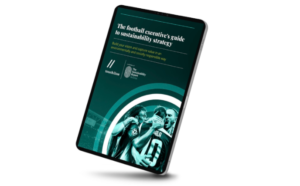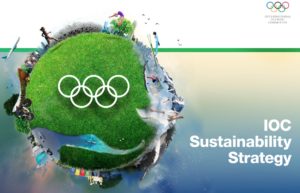
World Athletics (WA) is the global governing body for the sport of Athletics. Today World Athletics encompasses track and field, race walking, road running, cross-country, mountain and trail running. Boasting 214 national Member Federations, World Athletics has significant global reach, and is responsible for the worldwide development of the sport of athletics. World Athletics is committed to ensuring that its athletics events, which are held all over the world, and its headquarters, based in Monaco, are fully aligned to the principles of sustainability. This is in recognition of the growing environmental challenges that the world faces today, specifically air pollution, climate change and our overconsumption of resources. Those, coupled with a lack of global equality and diversity, create an environmental and social impact that poses a serious threat to the quality of our lives and communities. Sustainability within athletics is defined as driving the practices and behaviours of all individuals and organisations developing the sport in such a way that it:
- accounts for the needs of future generations;
- provides a fair and level sporting platform based on sound ethical principles;
- actively involves interested parties and is open about decisions and activities; and
- ensures actions take a balanced approach to their social, economic and environmental impact
- better management of the sport’s social and environmental risk factors;
- identification of opportunities benefitting the sport and engaging a wider group of stakeholders;
- more efficient use of resources delivering lower operating costs enabling greater investment in the sport; and
- wider activation platform for partnerships to bringing significant economic, social and environmental benefits to local communities.
- leadership in sustainability;
- sustainable production and consumption;
- climate change and carbon;
- local environment and air quality;
- global equality; and
- diversity, accessibility and wellbeing.













International Rafting Federation – Sustainability ideas for rafting event organisers
This guide is a continually growing list of practical ideas for event organisers to take on.



International Rafting Federation – Sustainability ideas for operators, instructors, guides and recreational rafters
This guide includes a continually growing list of practical ideas to be taken on operators, instructors, guides and recreational rafters.



International Rafting Federation – Practical Guide to Sustainability
In January 2021, the international Rafting Federation launched a series of practical guides to help rafters across the globe undertake a more sustainable approach to rafting.
The first guide is a “living” document which will be evaluated and revised on a regular basis, in response to changes in technology and the understanding of the significance of environmental sustainability in the sphere of rafting.
Content include:
A. Our commitment to Sustainability
B. Sustainability in all Rafting
C. Sustainability in Recreational Rafting, Racing and Guiding
D. Sustainability in Rafting Events
E. As an Athlete - what can I do?
F. Notes
G. Resources



The football executive’s guide to sustainability strategy
The Sustainability Report publishes our first white paper in collaboration with Touchline to explore the elements of a good sustainability strategy for football clubs, leagues and tournaments
Like so many sectors, the football industry was devastatingly exposed by the coronavirus pandemic. While most of the top European leagues and tournaments managed to navigate towards a conclusion, there was a peculiar and disconcerting feeling to it all.
And while many in the game will be hopeful that solutions will be found to the public health crisis and, in the short-term, bringing people back into stadiums safely, what’s happening now could be the tip of the iceberg.
Climate change and its impacts have the potential to impact football – both grassroots and professional – in an even more negative and profound way. A piece of research conducted by renowned journalist David Goldblatt and the Rapid Transition Alliance found that, in England alone, a quarter of its 92 professional league clubs could be affected by flooding every season.
Sustainability is a growing topic of interest within the world of football, but being sustainable is not just about managing risks like climate change – it’s about building a vision that captures value. It’s about strengthening relationships with fans. Becoming more efficient. And improving your brand and reputation.
Together with Touchline – our parent company and agency that specialises in sport, sustainability and reporting – we’ve put together ‘The football executive’s guide to sustainability strategy’ to help those in the football industry who want to get started with sustainability, but don’t know where to begin.
The guide explores how a football organisation can capture value through sustainability, and also how you can build your vision and align sustainability objectives with stakeholder priorities and international standards. We’ve reflected on some of the latest research in this area, and captured the experiences of some of the most renowned sustainability professionals in football, including:
– Patrick Gasser, UEFA’s head of football and social responsibility
– Bodour Al Meer, environment and sustainability senior manager for the Supreme Committee of Delivery and Legacy (Qatar 2022)
– Orjan Lundberg, sustainability expert for the Supreme Committee of Delivery and Legacy (Qatar 2022)
– Nico Briskorn, VfL Wolsburg’s head of corporate responsibility
– Andrea Maschietto, Juventus’ sustainability and external relations manager


The International Biathlon Union (IBU) launched its Sustainability Policy on October 12, 2020. This Policy provides the roadmap for the federation’s ten-year Sustainability Strategy 2020-2030 and outlines how the IBU will honour its commitment to establishing biathlon as a leader in promoting and upholding the highest standards of sustainability in sport.
The Policy builds on the work the IBU begun with the approval of its strategic plan Target 26 and demonstrates the IBU’s ambitions by going beyond minimum requirements and setting an example that will influence change across the world of sport.






FIFA recognises its obligation to uphold the inherent dignity and equal rights of everyone affected by its activities. This responsibility is enshrined in article 3 of the FIFA Statutes, according to which: FIFA is committed to respecting all internationally recognised human rights and shall strive to promote the protection of these rights.
This human rights policy specifies FIFA’s statutory human rights commitment and outlines FIFA’s approach to its implementation in accordance with the UN Guiding Principles on Business and Human Rights.




The IRF’s aim is to ensure the sport of rafting is sustainable. To achieve this goal, each event should monitor and take appropriate actions to limit the impact on the environment.
Events have an impact on the environment through:
- direct resources (electricity, water, food, etc);
- indirect (consumption of energy and creation of Co2 related to transport to the events, etc);
- the waste created immediately and on the longer term (dishes, equipment’s, paper, etc
All these elements compose the ecological footprint of an event. Environmental considerations have to be taken into account before, during, and after the events.
Before the event: Most of the ecological footprint reduction can be completed through good planning from the very beginning as that is when you set in stone the overall framework of the event.
During the event: During the event, the organizers need to make sure that the strategies agreed with the venues’ managers and other stakeholders are properly implemented. They will also need to assist attendees and participants in their own individual efforts to contribute to the event’s ecological footprint reduction.
After the event: Organizers will communicate the results to relevant people (venue’s managers, participants, etc).
It is important to take advantage of the efforts put into these event to spread the message that organizing greener events is possible.




This guide to Climate Action is part of the “Sustainability Essentials” series developed by the IOC. IOC aim here is to provide a general understanding of the issues related to climate change and managing carbon (or greenhouse gas/GHG) emissions. The IOC examine what this means, why it is important, how it relates to sport and what a sport organisation can do to address climate change. In addition, IOC look at climate adaptation measures that organisations increasingly need to adopt in order to continue their day-to-day activities in the face of more extreme and variable weather patterns.





Sustainability is one of the three pillars of Olympic Agenda 2020 alongside credibility and youth. In line with its recommendations, the IOC has developed a Sustainability Strategy. Based on the responsibility of the IOC as an organization, as the owner of the Olympic Games, and as the leader of the Olympic Movement, it focuses on infrastructure and natural sites, sourcing and resource management, mobility, workforce, and climate.
Here you can find the following elements of the IOC sustainability strategy.










